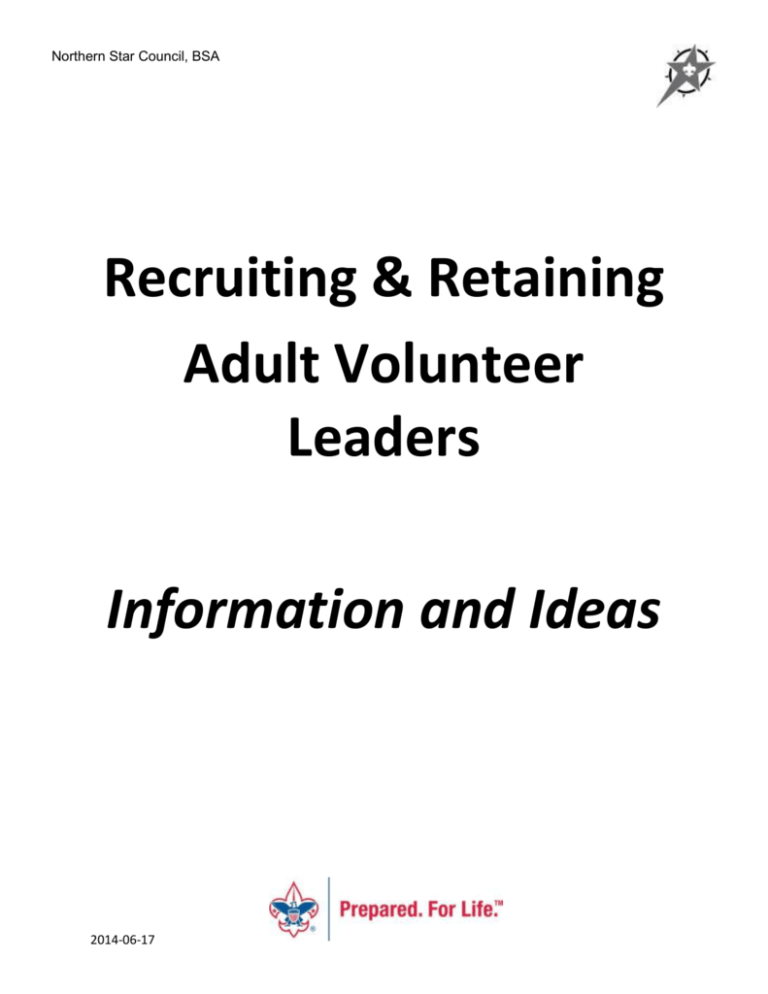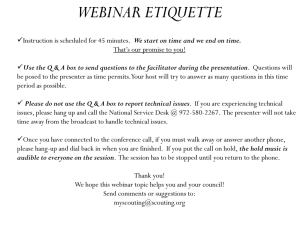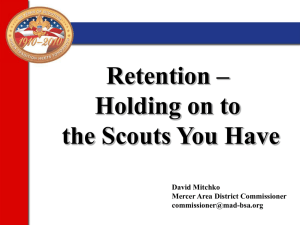Recruiting & Retaining Adult Volunteer Leaders Information and Ideas
advertisement

Northern Star Council, BSA Recruiting & Retaining Adult Volunteer Leaders Information and Ideas 2014-06-17 Northern Star Council, BSA Tips for Recruiting Parents to be Scout Leaders Tips for success in recruiting adults: 1. Provide a calendar of upcoming events and activities. Everyone is busy, and scheduling is of the utmost importance. 2. Provide very short expectations for the volunteer role. It should include the name of the position, the tasks needed, the time frame, and who they should be able to go to for help or guidance. 3. Provide them a date, time and location for any training sessions that would help them become successful. 4. It needs to be a personal ask – standing up in front of a large group of people and stating: “we need help, if you are interested please call me or see me after the meeting” will not work! People do not respond to this because the expectations are not clear, and everyone is always rushing around. Also, many volunteers look around and believe that “I am only one person, there are so many others – it will be fine”. Before you know it – that becomes a group mentality, and the pack is running very shorthanded and the program suffers, or people become overwhelmed and burn out. 5. Share with them why they have been chosen, what particular skills or abilities they have that are needed. People are more willing to help with things they know, enjoy or are good at. There is a very real fear of the unknown. 6. Create an environment that Scouting is a family program, and that parents are involved in something throughout the year, and provide a list of activities, roles, and committees for them to become a part of. Get the information back from them, and be sure to follow up with them in a timely manner. Make sure that Scouting is not a “spectator sport” – we are all involved at some level. 7. Have them be a part of planning the program, by asking them what they would like to see the pack do throughout the year. Write their name down beside the idea. They are a prospect to be the chair for this activity, or at least on the committee. 2014-06-17 Northern Star Council, BSA “Scouting and the Family” Let it be known, that Scouting is a FAMILY PROGRAM …. 1. Begin by holding a “BRAINSTORMING SESSION” with the families in your unit – what are their interests? 2. Then, match their interests with your advancement program or future activities. I. Units working together 1. Set a calendar, with 2 – 3 family events per year. This can be packs with packs, packs with troops, etc. 2. Select a theme for each. 3. Utilize older Scouts as mentors for the younger siblings. See “Venturing …BSA’s Older Sibling” (Northern Star Council Venturing handout) for a sampling of themes and skill levels for Cub Scouts, Boy Scouts and Venturers. II. Involving families within a unit 1. Set a calendar, with 2 – 3 family events per year. 2. Select a theme for each. 3. Identify programs that can be done at all skill levels – and set up areas for each. Examples of activities / skills that run through the Scouting program are: cooking, first aid, swimming, hiking, land navigation, fishing, biking, crafts, wood working, its endless! III. Involving families at unit meetings For Pack meetings, Troop meetings, Courts of Honor – have a special place for younger siblings to go and have fun, have a place of their own. What do other like organizations do? 1. Some places of worship, have areas with adults that watch over younger siblings, and have activities to do at their level. It may be coloring, it may be a movie, it may be arts & crafts, or games. I know of a Cub Scout Pack that had a “Deer Den” for siblings. They had their own adult volunteers, many times even the older girls in the family who couldn’t be Cub Scouts or Boy Scouts helped out. 2. Allow them some recognition. At Pack meetings, do younger siblings get recognition for good behavior? For the projects that they have done? For anything – be creative. Recognition does not have to be every month – maybe quarterly. 3. Does your unit have meetings that enable younger kids to burn off some steam? Is there a playground or outdoor area for them to be active, as most of them tend to be. Many times, we need to forget about trying to get them to adapt their behavior, and focus on how we can adapt the situation to serve the most possible. 2014-06-17 Northern Star Council, BSA (“Scouting and the Family”, Continued…) IV. Last, but not least… Remember to encourage your families to work on Scouting in the family; at home, at the cabin, on vacation, on a short day trip. Do this by: 1. Have a set calendar – that details what projects or skills will be done in the book at your meetings, and what is expected to be done at home. 2. Share and promote family opportunities in the book – that day of fishing or boating can be an item signed off. 3. Share and promote opportunities for family activities like the Twins, Saints and Timberwolves games; helping with Scouting for Food (even the older non-Scouts can do this!); special Scout ski days, or even the local activities such as: Lark on the Monarch, Wood Duck Walk, or a trip to the Science Museum. 2014-06-17 Northern Star Council, BSA Share the Story and the Meaning of the BSA Tell the story of the Boy Scouts of America. The Boy Scouts of America was founded in 1910 for boys ages 11 and older. In 1930, the Cub Scout program was created, because of the demand from younger boys to be able to participate. Lord Robert Baden-Powell took on the challenge of the new program which he called “Cubbing”. While Boy Scouts had their badges of rank, Baden-Powell felt that the Cubs needed to have a story and badges that they could identify with. He chose to use “The Jungle Book”, by Rudyard Kipling, as his base for Cubbing. Cub Scouting was billed as a grand adventure, and Cubs could envision the fun, excitement and building skills needed to survive in a jungle as Mowgli did in the story. As boys developed their skills, they earned badges associated with the animals in the story: Lions, Tigers, Wolves, Bears. Later Bobcats were added. The Cub Scout sign which is two fingers of the right hand extended and held high are even described to represent the ears of the wolf – when the Cub Scout sign goes up – the Cubs are to act as wolves do, to become quiet and listen to their leader for what is to happen next. More than 80 years later, your boys are the latest in a long line of Cub Scouts to have joined the ranks of Scouting, and in doing so they are about to embark on a journey of their own. Keeping true to the story – they will be in “dens” (groups of boys from the same grade) – Lions, Tigers, Bears. No snakes though – because snakes just freak too many people out. Dens typically are between 5 and 10 boys meeting weekly. All of the dens belong to a larger Cub Scout group, called a “pack” – the entire pack gets together once a month. The primary purpose of a pack meeting is to celebrate all that has been accomplished during the month by presenting awards earned by the Cub Scouts. Pack meetings also provide needed information to the families who belong to the pack. Now, where do the parents fit in? Scouting is a FAMILY program. There are even parts of your son’s Scout book that he is expected to do at home. Youth protection in the front cover, participating in and even planning activities as a family, working on awards for the family, even activities and discussions on the faith of the family. Most importantly – the adventure your son is beginning to take tonight, is a journey that you should be a part of. Join him on this journey be alongside him through the fun and excitement. Be a part of planning and carrying out events that will be a part of the adventure. To be a volunteer leader for your son and other Scouts is to begin a journey of fun, excitement, and of fulfillment that others will never know. The books are written at the age level of the youth who will be using them, and training is available. Scouting offers you the ability to literally be a part of their experience, not just be a spectator. You may not realize it now, but many years from now the investment of your time and talents as a Scout leader will be invaluable to the both of you. 2014-06-17 Northern Star Council, BSA Host a Recruitment Party Host a party for the parents!! Everybody wants to be invited to a party, but few are excited about attending a meeting. The party was attended by about two dozen parents. At the end of the meeting, about 90% of the households that attended had at least one parent step up to a position. Here are the details: The party was held in the cafeteria of the school we met in, and the unit paid for pizzas, paper plates, napkins, cups, etc. Half of the parents from odd numbered dens were asked to bring beverages to share, the other parents were asked to bring snacks to share. Several party games / contests were played: 1. Everyone was given half of a walnut shell, 6 small feathers, 4 pipe cleaners, 2 wobbly eyes, and a piece of wire. On the table were a couple of hot glue guns. Everyone was given 15 minutes to create a masterpiece to be worn as a neckerchief slide. We had ribbons for all participants. 2. We had a few hula hoops in the back of the room, along with a couple of small fishing rods. The contest was to land your casting plug in to the hula hoop in 6 attempts. The one who had the most in – won! 3. Everyone was taught how to tie a square not. The group was divided up in to 4 groups of 6. On the word “GO!”, each person in each group was to tie a square knot. The group that completed the task first – was declared the winner – as long as all knots were tied correctly. For a Cub Scout pack: 4. Each group was given 10 minutes to play a game of marbles. 5. We played a game of “AKELA Says”, a spin on the game of “Simon Says”. At the start – AKELA demonstrated several new actions: the Cub Scout salute, the Cub Scout Sign, and the Cub Scout handshake. During the game – those with the correct actions, take one step ahead. Including the new Cub Scout actions! For a Boy Scout troop or Venturing Crew: 6. Placing cotton balls in a Ziploc bag, “smooshed” around with Vaseline makes great fire starters. 7. Have a “fire by friction” contest – fun and challenging! At the end of the night, everyone knew each other much better, and everyone had a blast. We explained that everything they experienced was going to be the future experiences for their boys in Scouting, and that we needed their help to deliver these experiences. And they can have fun at it! We explained that the books are all written at a reading level for the young people using them, and are as simple and as fun as what we have done tonight. In fact – the fishing portion is from the Wolf book, learning to tie a square knot is from the Bear book, the game of marbles can earn them a belt loop from the Sports and Academics program, and the AKELA Says game gets them nearly halfway to earning their Bobcat badge. That neckerchief slide they made – they would be able to wear with their official uniform!! 2014-06-17 2014-06-17 Northern Star Council, BSA Conduct a Reflection Begin by asking the group to think back to their childhood. Was there one person who they remember as being an influence on their life? This person could have been a teacher, a coach, a pastor or priest or a mentor. It may have even been a Scout leader. It could have been a parent, a grandparent, or other family member. Ask everyone who remembers such a person to raise their hand. It has been my experience that nearly everyone will. Next, ask for some reasons that this person made an impact on them. What did they do for you? Most of the time answers will be: they were there to help achieve a goal or get through a hard time. This person is often described as a good listener, patient, helpful. Rarely do you hear of a specific skill. Now – share with the group that they have an opportunity to be just such a person to a group of young people. Scout leaders are often described by the Scouts as being a good listener, helpful, and FUN. They want someone to trust, someone they can count on. Being a volunteer in Scouting allows you the ability to be this person. We provide the books and the training. And the great thing about Scouting is that Scouting is a FAMILY program. In 15, 20, or 25 years from now, your son and other men may be in the position of reflecting back on the people who were a great influence on them as a youth. You have the opportunity to become that person now, by volunteering your time and talents in them as their Scout leader. And if you do not have time to be that leader who works with youth every week, that is ok. We also need volunteers for annual events such as our Blue and Gold banquet (a party held each February to celebrate the birthday of Scouting), unit fundraising events, chaperoning at day camps or resident camps, helping with the annual Pinewood Derby, or even with bookkeeping. Often times being able to help transport Scouts or teach a simple skill, such as: cooking, baiting a hook or finding a constellation in the night sky is what is needed. The opportunities are endless! To be a volunteer leader for your son and other Scouts is to begin a journey of fun, excitement, and of fulfillment that others will never know. The books are written at a level for the young person who will be using them, and training is available. Scouting offers you the ability to literally be a part of their experience, not just be a spectator. You may not realize it now, but many years from now the investment of your time and talents as a Scout leader will be invaluable to the both of you. 2014-06-17 2014-06-17 R:\Share\Membership\Fall Recruitment\2014 SNFS\Unit Training folder\6 – Recruiting Parents Book.docx



